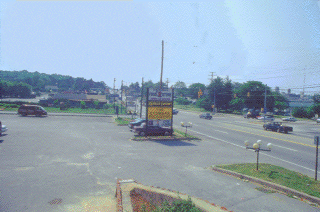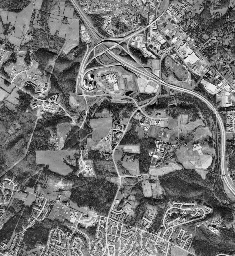
Commercial Strip Development near Owings Mills

Owings Mills, because of its peculiar preconditions of transportation,
development and ecology has the potential to serve as a positive example
of what the developing urban entity of the edge city could be. It is
equally poised, however, to become yet another example of the placeless
wasteland of isolated buildings, parking lots and despoiled waterways
that is rapidly becoming the normal condition of the American
landscape.

Commercial Strip Development near Owings Mills
A particular focus of this study was the development of
design proposals that address the growing realization that natural
systems and urban systems need to be seen as a whole
continuum that must be treated in a complete and coherent manner.

Metropolitan Baltimore--project site highlighted
Owings Mills contains a unique set of circumstances that make it
potentially valuable as a model of the "sustainable city". In one
relatively concentrated area it contains all the necessary functions of
a viable city: industry, commerce, residences and a highly developed
transportation and water infrastructure, including mass transit, all
directly adjacent to a complex and fragile aquatic ecosystem.

Aerial Photograph of study area, courtesy of Air Photographics, Inc.
What is missing, and this study hopes to provide, is a model whereby all these attributes can be coherently organized into a city that is designed for pedestrians as much as it is for automobiles and as sensitive to the needs of natural systems as it is to those of people. The goal is to produce specific design solutions that integrate urban and natural systems into a habitable public landscape.
Jack Dillon, David Field, and Pat Keller of the Baltimore County Department of Planning and Zoning and Rocky Powell of the Baltimore County Department of Environmental Planning & Management have been very supportive throughout the long process of developing this project. At the design charrette at Owings Mills the participation of the local land developers was crucial to understanding the project and Terry MacHamer in particular was tremendously helpful in organizing and funding the charrette.
Neal Payton of the Catholic Unversity of America, his design students and the students of my own design studio were all a crucial part of the Web-based collaborative experiment of this project. Through them we were able to develop graphic depictions of alternative development scenarios for Owings Mills.
Kris Karlsson and Dan Ancona, research assistants for the entire project were quite literally the co-authors of this report and their combinations of energy, inquisitiveness and dedication made the work possible. Joe Eades and Keith Robbins were other student assistants who made significant contributions.
All of the staff of the Institute for Advanced Technology in the Humanities were, of course, the only reason this report got done at all and Christie Stephenson, Digital Image Librarian was extremely helpful in facilitating image scanning, whether in a crisis situation or not.
 IATH WWW Server |  Introduction |
 Send Comments |